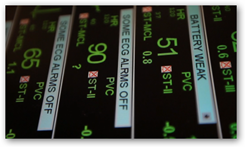I can relate to the bad algorithms after being in the hospital myself with the pain drip machine falling offline and waking me up a lot. Well that’s just my tiny world there but the hospital staff lives and breathes these things every day. So my experience with the device above is only one tiny device compared to what goes off in a hospital. This is a good study and well worth it to get some data on what’s going on. This is not the first time this topic has been brought up either but I think it’s the first time there’s been “real” data to look at to see how bad it can be.
waking me up a lot. Well that’s just my tiny world there but the hospital staff lives and breathes these things every day. So my experience with the device above is only one tiny device compared to what goes off in a hospital. This is a good study and well worth it to get some data on what’s going on. This is not the first time this topic has been brought up either but I think it’s the first time there’s been “real” data to look at to see how bad it can be.
Alarm Fatigue and Health IT interoperability Are Top 10 Challenges Today With Medical Engineering And Pushing Some to Technology and Occupational Burn Out
Every time an alarm goes off there’s a purpose to it and with 88% of the Arrhythmia Alarms being false positives, you and I and anyone else would tune them out as you know there’s good odds that it’s a fake alarm and it goes down the list of priorities to attend to, and shut it off.
This study was done at USCF a big hospital and they have a lot of automation all over to include alarms. A while back this video appears in the Boston Globe and it’s worth repeating to watch again.
Is that screech enough to get your attention in the video, hold your ears. The “toxic” alarms of course are the ones that require urgent attention and even the video they talk about the false positives. They spend a lot of time chasing alarms and now we have a number to put to it. Interfacing between devices and information systems is about the biggest problem and there’s more such as broken connectors and so on. With more devices entering medical data, I again think the ONC would be miles ahead to be over at the FDA as EMRs and devices, just due to the way technology is rolling are growing together and that way they would have two points of view from safety and the records portions and I would think we would win there. BD
Newswise — Following the study of a hospital that logged more than 2.5 million patient monitoring alarms in just one month, researchers at UC San Francisco have, for the first time, comprehensively defined the detailed causes as well as potential solutions for the widespread issue of alarm fatigue in hospitals.
Their study is in the Oct. 22 issue of PLOS ONE and available online.
The issue of alarm fatigue has become so significant that The Joint Commission, a national organization that accredits hospitals, named it a National Patient Safety Goal. This goal requires hospitals to establish alarm safety as a priority, identify the most important alarms and establish policies to manage alarms by January 2016.
“There have been news stories about patient deaths due to hospital staff silencing cardiac monitor alarms and alerts from federal agencies warning about alarm fatigue,” said senior author Barbara Drew, PhD, RN, David Mortara Distinguished Professor in Physiological Nursing in the School of Nursing at UCSF. “However, there have been little data published on the topic to inform clinicians about what to do about the problem. Our study is the first to shed light on cardiac monitor alarm frequency, accuracy, false alarm causes and strategies to solve this important clinical problem.”
During that time period, a staggering 2,558,760 unique alarms were recorded, many caused by a complex interplay of inappropriate user settings, patients’ conditions and computer algorithm deficiencies. This includes a subset of 1,154,201 arrhythmia alarms, of which 88.8 percent were determined to be false positives caused by the algorithm deficiencies.



0 comments :
Post a Comment